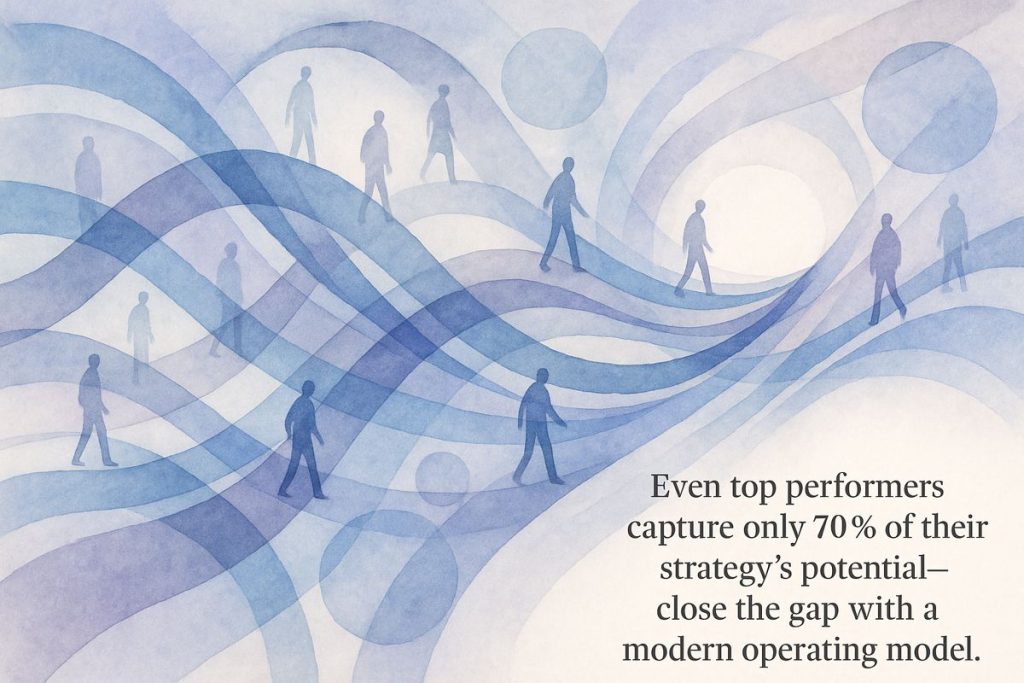A modern operating model is like a living system that connects a company’s big ideas with everyday work. It breaks down barriers, uses smart tech, and helps teams work together, turning plans into real results. Many companies lose 30% of their potential because their way of working gets stuck or confused, not because their ideas are bad. The best operating models are flexible, always ready to change, and help everyone stay clear and connected. This way, even tough industries like pharma can react fast and keep growing.
What is a modern operating model and how does it help organizations achieve measurable results?
A modern operating model is a dynamic system of processes, structures, technology, and culture that aligns strategy with day-to-day execution. It breaks down silos, integrates data, enhances agility, and fosters collaboration—helping organizations turn boardroom strategies into measurable results and close the persistent 30% execution gap.
The Silent 30%: Why Execution Eats Ambition for Breakfast
Some mornings, when the coffee’s hot and the inbox is mercifully quiet, I get fixated on numbers. Here’s one that lingers like the aftertaste of burnt espresso: thirty percent. According to a 2025 McKinsey study, even the sharpest organizations—Pfizer, SAP, you name it—leave nearly a third of their strategic value on the table, year after year. Not because the vision’s lacking, but because something gets lost (or trampled) on the long march from the glossy strategy deck to day-to-day results.
You’d think this would be caused by weak leadership or woolly goals, but the evidence says otherwise. It’s the operating model—the invisible exoskeleton of process, structure, and culture—that buckles. Take pharmaceuticals: workflows snarl, data lives in isolated silos, and compliance is a labyrinth with Minotaur-sized headaches. I once watched a mid-sized biotech try to roll out a digital reporting tool. The software was sleek, but the project fizzled. Turns out, the teams involved hadn’t agreed on a common language for metrics, making every discussion a cacophony. (I still wince when I hear “alignment.”)
But why is this gap so sticky? Maybe because, as Quantive points out, aligning cross-functional groups and integrating new technology feels a bit like teaching synchronized swimming to cats. Still, the companies that bridge this chasm—somehow—achieve something akin to a hyperspectral upgrade for their bottom line. You can practically hear the collective sigh of relief when it clicks.
Anatomy of an Operating Model: More Than Org Charts and Wishful Thinking
Let’s get concrete—no more hand-waving. An operating model isn’t just who reports to whom or which SaaS dashboard is trending this quarter. Think of it as a palimpsest: a living system where old habits, new technologies, and unspoken rules overlap (and occasionally clash). McKinsey’s “Organize to Value” framework sketches this out with 12 customizable levers, from purpose and leadership to tech infrastructure and talent management. It’s detailed, even a bit labyrinthine—like reading a Borges story, if Borges consulted for Novartis.
JD Meier argues that the real secret sauce is in data platforms: unify them, and suddenly decisions travel at the speed of thought. I’ve seen it firsthand—one company swapped their rickety Excel maze for a cloud-based workflow tool and slashed response times by 40%. The transformation was as tangible as that first, bracing sip of cold brew on a sweltering July day.
But models aren’t magic. They require calibration—a sort of internal “fingerprint discovery.” McKinsey prescribes a four-step process: admit where you’re bottlenecked, design a custom blueprint (never copy-paste), pilot ruthlessly, then scale what works. Each step is a little nerve-wracking. I once doubted whether our own team could adapt to a new agile structure. There was skepticism, some grumbling, and—full disclosure—a near-mutiny over meeting formats. Eventually, we found our rhythm, but not before I questioned every assumption I’d made about collaboration.
From Pharma to Fintech: Adapting Under Pressure—and Regulatory Gaze
Operating models aren’t one-size-fits-all. In pharma, you’re juggling FDA updates, scientific revolutions, and a stakeholder chorus that includes everyone from regulators to patient advocates. The texture of the work feels different—sometimes sharp-edged, sometimes slippery. A single compliance misstep can set off alarms (literally; I once triggered one with a botched document upload. The resulting uproar was operatic).
Digital transformation isn’t just a buzzword here. It’s oxygen. Integrated data and modular systems let organizations respond to regulatory shifts and scientific discoveries fast—sometimes within days instead of quarters. Businessmap notes that agile decision frameworks are the difference between swiftly dodging a meteorite and just watching it approach, eyes wide.
And yet, even with the niftiest tech stack, the human element rules. Leadership’s got to foster a climate where people don’t just comply—they contribute. I’ve felt the stubborn anxiety of launching a new process; it smells like burnt toast and stale conference coffee. But clarity of purpose, especially when reinforced by tools like the McKinsey 7-S model, can cut through confusion. Regular reflection—sometimes painful, often necessary—turns missteps into muscle memory.
Perpetual Motion: Operating Models as Living, Breathing Systems
Here’s the kicker: no model, however elegant, stays evergreen. The zeitgeist demands iteration. As The LBM wryly notes, most operating models emerge by accident—then sit there, barnacled with outdated rules. The trick isn’t in building the perfect structure, but in fostering a culture that expects change, welcomes tweaks, and never mistakes inertia for stability.
Every framework—from McKinsey’s to legacy classics—needs revisiting. I’ve learned (sometimes the hard way) that the best operating models are less blueprint, more jazz improvisation. They absorb shocks, channel new energies, and, when necessary, toss the rulebook.
So next time you’re staring at that 30% performance gap, ask yourself: is it strategy that’s lacking, or the messy, beautiful machinery that turns ambition into action? Either way, another cup of coffee can’t hurt.
